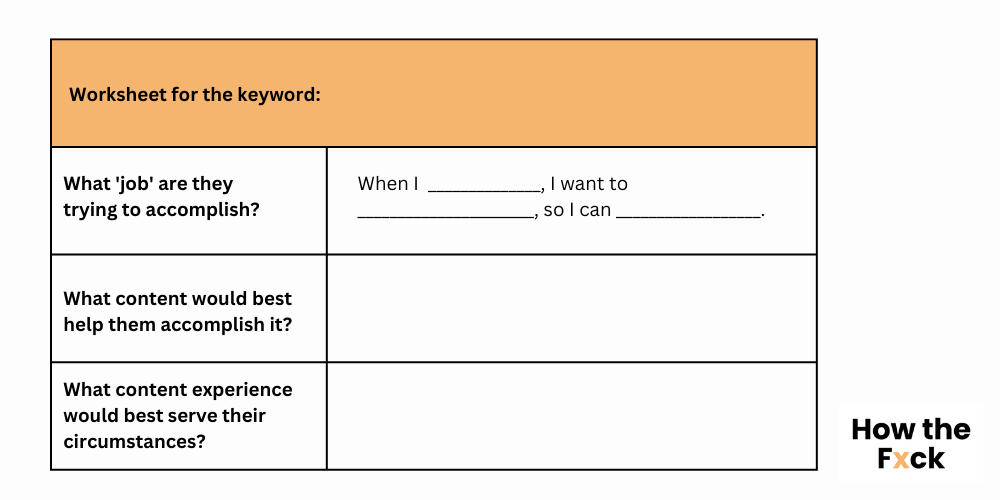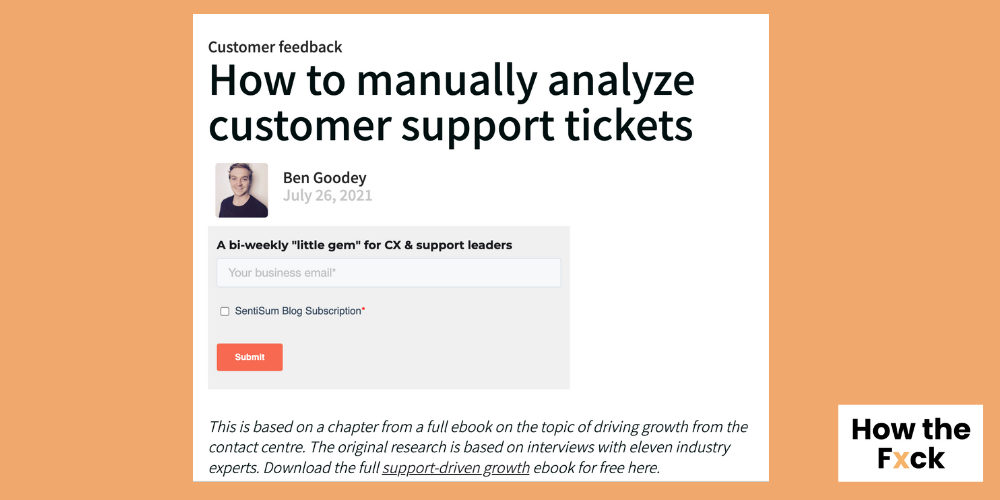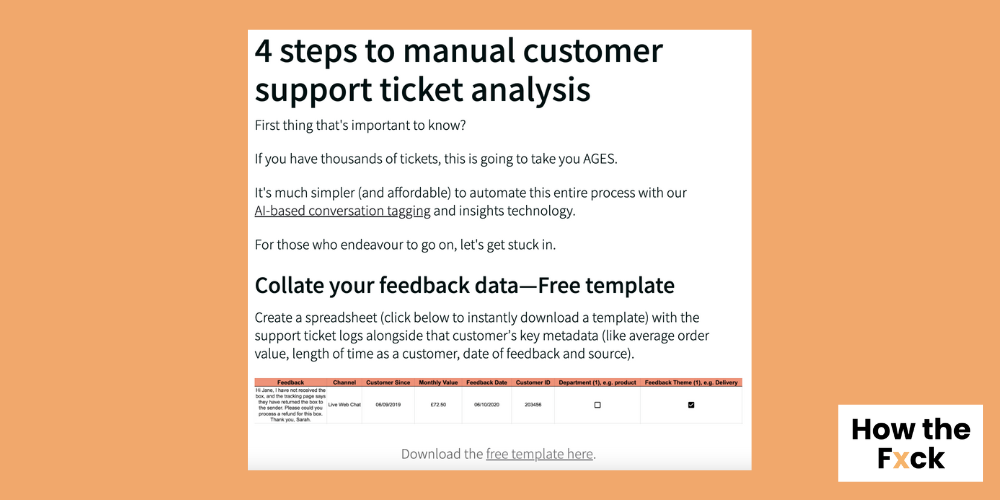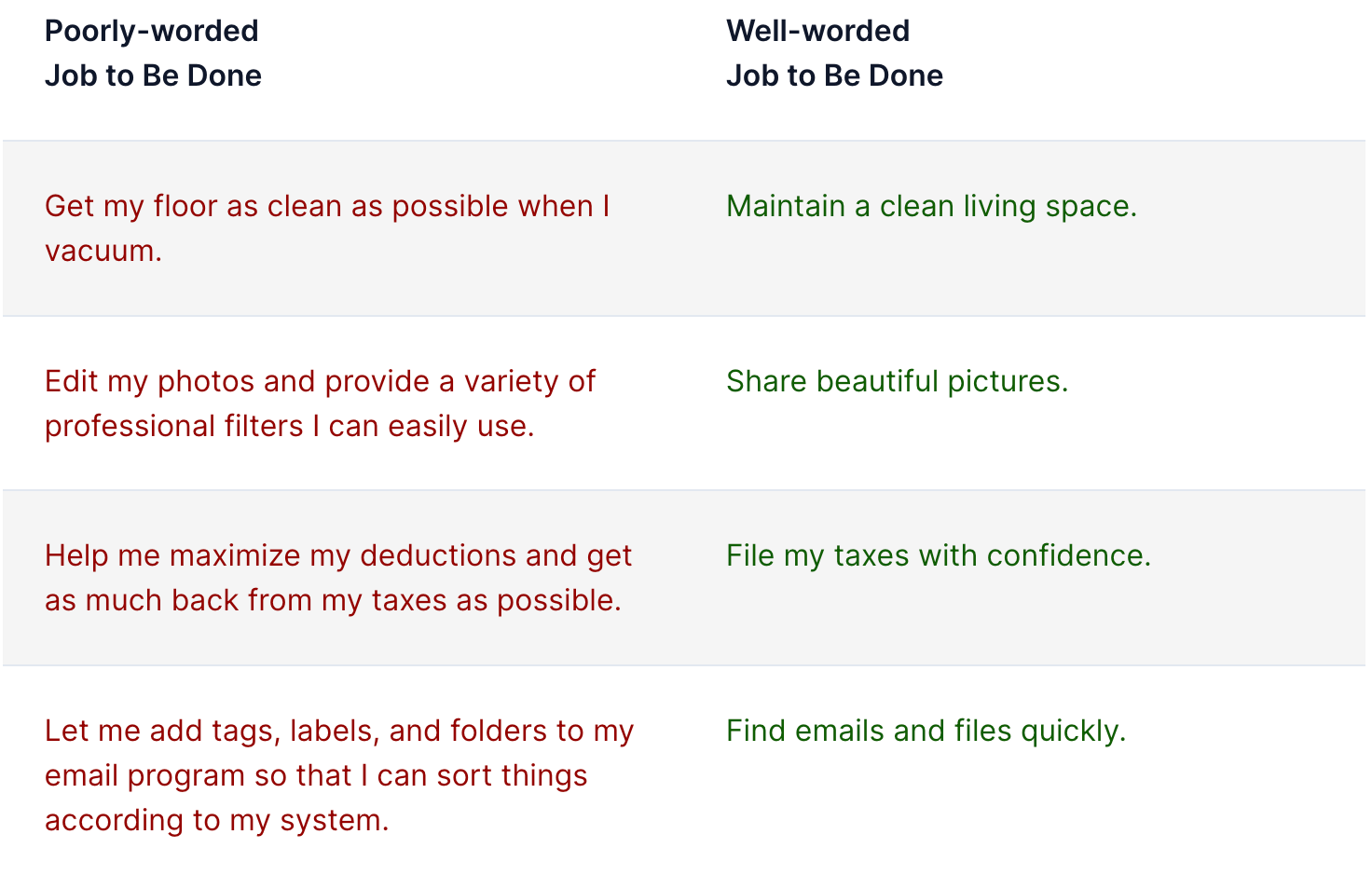Top SEOs use Jobs-to-be-Done to create the highest quality content for search engines. In this article, we look at the theory, practical steps, and examples from companies like Canva.
In the early 2000s, Bob Moesta, an innovation consultant, was charged with boosting sales of new apartments built by a construction company in Detroit.
Like any great marketer, Moesta started his process with customer research. He interviewed people who had bought units already, asking them to “draw a timeline of how they got here.”
The first thing he discovered? There was no pattern in who was most likely to buy. No demographic or psychographic similarities appeared. Nor was there a particular set of features buyers valued enough to tip their decisions.
However, the conversation revealed something unusual. Whereas prospective buyers said they didn’t need a formal dining room, actual buyers talked about the dining table repeatedly.
“People kept saying, ‘As soon as I figured out what to do with my dining room table, then I was free to move,’” said Moesta.
He thought this was a little bizarre. But, as he sat at his own dining table with his family that night…it all clicked into place.
What was stopping downsizers from making the decision to move wasn’t features or demographics, but the fear of giving up memories and meaning.
Moesta recalls something powerful:
“I went in thinking we were in the business of new-home construction, but I realized we were in the business of moving lives.”
The company changed its offering to create space for dining room tables and focused on reducing the anxiety of moving houses by providing things like moving services.
Of course, the results were wildly successful.
This article explores how this mindset can help content & SEO marketers think out of the box about the content they create.
I believe this is how you can stand out in the SERPs and develop winning SEO-focused experiences in an ever-competitive content world.
The Business of Moving Lives—the Jobs To Be Done (JTBD) Mindset
Jobs To Be Done (a now widely known and adopted methodology) is the theory of shifting your mindset from “we build new homes” to “we move lives”.
It’s a monumental shift in mindset. It reframes the innovator’s job as one of helping individuals seek to accomplish a goal (a “job”) which considers the entire experience a person is trying to create.
SaaS companies are no longer “building X” they’re “helping people do Y”.
How does this change the innovator & marketers' view of the world?
1/ Customer demographics & product features are no longer in focus. Instead, customers' circumstances are more important.
In my interview with April Dunford last year, she made an extremely important point about this:
“Find your true competitive comparable. Don't make the mistake of thinking your competitor is another company that makes similar software. It might be, but it's likely that your real competitor is something more simple: the way your customer is solving the problem right now. If they are using an intern to do that annoying task, then you better be explaining why your product is better than chucking an intern at the problem.”
Through the lens of circumstances, the competition looks different. Instead of competing against other software providers, are you sure you aren’t competing against an Excel spreadsheet that currently helps your customer achieve the same goal?
2/ Efforts should be focused on problems with inadequate solutions—or no solutions.
Those wanting to downsize may want a simpler life, but they don’t want the anxiety of moving their life. It’s only when option three appears do they make the move and a want becomes an action.
3/ “Jobs” are not just functional, they’re social and emotional, too.
Focusing on features alone only taps the rational brain’s ‘what do I need’ and forgets that decisions are not 100% rational for any buyer.
How to Leverage JTBD in Content Marketing
Increasingly you’ll have heard marketers suggest businesses should build “media companies, not marketing departments.”
In a media company, the content is the product. Its purpose is to deliver nothing but value to the reader—solving their problems & keeping them engaged.
A great content marketer, much like a JTBD-focused product manager, thinks of their content as a product itself. This reframing concentrates content teams around long-term value, where the focus is on the reader and their needs rather than what the brand gets in return.
Content that fulfills the reader's needs builds brand awareness, affinity, and word of mouth and over the long term, builds revenue.
Here are three ways you can bring that energy into your content:
1. Meet search intent better than ever—Win SERPs with better content product experiences
SEOs know that for content to successfully rank in search engines it must target, and clearly answer, the intent of the search.
For example, let’s take the keywords “retention rate formula”. The literal searcher here clearly wants to find the formula for calculating retention rate.
However, thinking about these keywords, could we go further than just writing up the formula in a blog post?
What does the search term “retention rate formula” say about the searcher? To me, it says a few things:
- One: Their “job” or outcome is they want to know their company’s retention rate. It’s not about the formula. A problem statement removes the solution (the formula) to understand what the searcher wants to achieve.
- Two: Retention marketing isn’t their day-to-day job if they forgot the formula.
With this in mind, I’d say the true intent here is to calculate retention, and the most desirable experience would be quick, educational, and reassuring.
👉 What content would help them achieve this goal?
First off, let’s explain the formula in simple terms. They want to be confident in the outcome and part of that in business is understanding what you’re doing.
However, once we've built trust, they don’t need the formula. They just need to calculate their retention rate.
In my opinion, an interactive calculator or downloadable “calculate retention using this Excel template” would better serve the JTBD than simply explaining the formula.
👉 What experience would serve them most?
They’re likely not experienced in retention marketing, so let’s keep things simple.
Build a landing page that makes the key content digestible, it could explain: your expertise, what inputs make up the retention formula, and other key questions.
Then build a content experience like the interactive calculator below. This one appears in Qualtrics’ article “How to Calculate Your Net Promoter Score”.
It’s particularly good because it explains the formula whilst delivering the outcome the reader wishes to achieve.
Instead of a blog post, this approach takes the reader from A to B and creates the right set of experiences, and builds them into the processes of the content.
If you want to build content that competes in the SERPs, this is the lens through which to view your next piece.
Steal this worksheet to use with your team:

Here's a filled-out example using the Qualtrics content:
2. Bring greater product alignment into your SEO strategy to drive conversions
One of the reasons companies like Canva and Figma are so successful is they stopped targeting individuals and started targeting Jobs To Be Done.
Whether you’re a marketer or CEO, there are times you’ll need Canva for the same thing—for example, to quickly whip up a Venn diagram.
Now, I’m not saying you should throw out your persona targeting and focus on JTBD, that’d be a long-term change for your product team.
But what content teams can do is serve content at that sweet spot between their customer’s needs and product value.
Content built in ‘A’ bring an audience to your website with a specific ‘job’, and it just so happens that your product is one solution to completing that job.
Convenient, huh?
Let’s look at this in action on three websites.
1/ Using your product to quickly serve the searcher’s need (must have a self-serve product, ideally a freemium one)
The example I mentioned a few paragraphs back, Canva, perfectly illustrates this technique.
I use Canva all the time because they make design SO easy, but funnily enough, I stumbled across them again when wanting to design the above Venn diagram. So let’s use it.
Keyword: “make a Venn diagram”.
URL discovered: Free Venn Diagram Maker
This page serves search intent in multiple ways. Firstly, the on-page SEO is well done. The content marketer doesn't just build a keyword-optimized feature landing page that upsells their product, they also teach you how to use their product to make a Venn diagram:
And they bring unexpected new information to the table that will help me create a better Venn diagram:
But, most importantly, they spotlight that I can use their product, for free, to create a great Venn diagram:
Of course, I was an instant conversion. It was all made so easy—exactly what Google wants to serve the reader with.
2/ Build unbeatable experiences with product-led content
Another great example of alignment between customer needs and keywords is webwhiteboard.com.
The keyword “web whiteboard” has 51,000 traffic potential. And it’s all won by webwhiteboard.com.
The team at A Web Whiteboard (AWW) built such a great content experience—the whole site is an instantly usable whiteboard—that they were unbeatable even by whiteboard leaders like Miro.
In my interview with the founder of AWW app last year we discovered why.
“The SEO team at Miro researched our SEO experience deeply with us and we came to a couple of unique conclusions.
Firstly, we were extremely focused on the simplicity, extreme simplicity, of the product. And our interviews showed that the #1 thing people love about the product is the simplicity.
Because the time to value is so fast, the visitor can play or use AWW app instantly, time on page is naturally high as every visitor plays around for a little while.
Google themselves told us that we should not focus on SEO but to focus on the user—give them high quality.”
This lesson is freakin’ fabulous, isn’t it?
The better you can serve the searcher’s Job To Be Done, with both time to value and overall experience, the more likely you are to win the SERP.
Google really thinks like this. So should you.
3/JTBD-aligned content can also be a simple blog post
Most of us don’t have the resources, budget or skillset to build content products as advanced as AWW App or even simple ones like calculators.
Luckily, a blog post will often be enough to rank highly and earn quality traffic. I’ve written many that target JTBD for SaaS businesses and they always convert readers to demo requests at a significantly higher rate.
Here’s one example from my past role that targets the keywords “support ticket analysis”.

Instead of waffling on about automated analytics, we decided to quickly stand out by enabling the reader with a guide to achieving this outcome themselves, manually.
We even included an ungated template to make it easier for them to do it.

Throughout, I explained why using an automated, AI product would lead to far superior outcomes (faster, more accurate, and *actually* possible with high volumes).
I believe this worked well for us because we led with value, hooking the reader in and along the way showing them that doing this JTBD manually was not ideal.
By reading this article, those who weren’t aware they had a problem, quickly moved to problem-aware, and those who knew they had a problem became solution aware.
Ahrefs’ content team is well-versed in this strategy. Just check out their guide to keyword research here and observe how they tie their product into the JTBD of the blog post.
3. Find & target underserved audiences
A great product nails a poorly performed, very specific job to be done. This is also true of great content.
If you want to guarantee your success in the SERPs, create content for search terms that are being underserved currently.
Use the worksheet above with your team to understand what would best serve your ideal keywords, and then head to the SERPs yourself to see which keywords present a gap in the market.
Typically, SEO experts tell you to look at what’s already ranking for the search term and do more of the same. I want you to throw that advice out and think more deeply about the content you produce.
Some More Examples of Unique Content Experiences
- CustomerGauge's NPS benchmarks library. This is an incredibly effective database of NPS scores from around the world. PS. I work here, I can vouch for the monthly organic volume.
- Gartner's Glossary. Imagine ranking #1 for 4.3k monthly volume keyword "channel partners" with just 30 words. They thought differently and built a glossary database content experience.
- Ahref's entire blog aligns their product JTBD and search intent incredibly well. Just look at how they incorporate their product and drive sign ups.
- Typeform's "Star Wars Guide to Net Promoter". The guide is pretty basic but it's a very unique and digestible way to teach an overdone subject.
- Hotjar's "Net Promoter Score" content hub. It's really easy to navigate around and covers all the essentials. Their ranking suggests this content must be getting 100,000s of monthly visitors.
- Yoga pose finder by Yoga Journal. I don't like yoga but I LOVE how they thought about this content library.
- Product-led SEO techniques used by Coinbase, Quora, Canva, Vimeo and many more top tech companies.
How to write better problem statements before writing content
Find your reader's JTBD by creating solution-agnostic, problem statements as part of your research process.
Here are some examples of what to do and what not to do:

Reframing your role around helping your reader achieve column two helps strip away assumptions about what's right, opening up a new world of innovative thinking. Deep dive into how to write these here.
Conclusion
I believe content experience is the future of SEO, and the faster we begin to think like product managers, the better our results will be.
To get you started on your JTBD journey, here are a few resources.
- An eBook on JTBD theory, explaining it thoroughly.
- A great Figma board worksheet to help you identify Jobs To Be Done
- Using outcome statements to reduce imperfections in your content
- The book that started it all: “Competing on Luck”
Key sources for this article:


